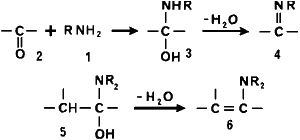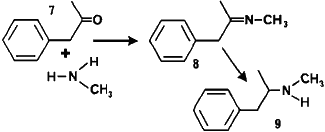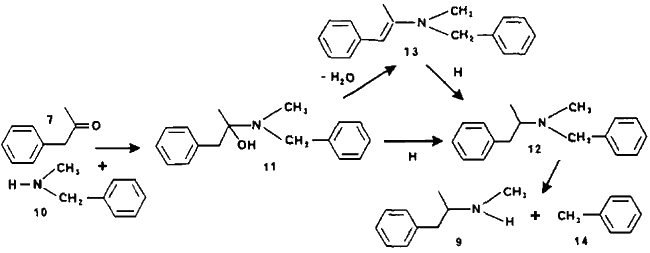Summary
Methamphetamine was synthesized by reductive alkylation hydrogenolysis of phenyl-2-propanone with N-benzylmethylamine. The expected product N-benzylmethamphetamine, once formed, undergoes hydrogenolysis to methamphetamine and toluene. The progress of the reaction, the intermediates formed during the reaction, and the products were analyzed by gas chromatography and mass spectrometry.
Introduction
The synthesis of methamphetamine from phenyl-2-propanone (P2P) and methylamine is a common method utilized in clandestine laboratories. Reductive alkylation hydrogenolysis of P2P and N-benzylmethylamine to form methamphetamine is not commonly encountered1. Reductive alkylation involves the reaction of a aldehyde or ketone with a primary or secondary amine in the presence of hydrogen and a hydrogenation catalyst. The reductive alkylation of P2P and methylamine with hydrogen and Pd/C (palladium on carbon) produces methamphetamine. The reductive alkylation of P2P and N-benzylmethylamine produces N-benzylmethamphetamine - also known as benzphetamine. Subsequent hydrogenolysis of benzphetamine produces methamphetamine.
Experimental
During this study, the one step hydrogenation reactions were run on a Parr pressure reaction apparatus in hydrogenation flasks with shaking at a hydrogen pressure of 50 lb. Hydrogen consumption was monitored by the pressure drop in the gas supply tank on the hydrogenator. Methanol was utilized as the solvent and 10% palladium on charcoal and/or palladium black was utilized as the catalyst.
The reactions were monitored by removal of aliquots from the reactions with subsequent analysis by gas chromatography (GC) and gas chromatography/mass spectrometry (GC/MS). The progress of the reaction was followed by observing the decrease in the concentration of the reaction precursors, the increase in the concentration of the final product, detection of intermediate compounds formed during the reaction, and detection of side products formed during the reaction. The gas chromatograph used was a Hewlett-Packard 5890 equipped with a flame ionization detector. It was operated in the split mode (100:1) using a 25m x 0.20 mm fused silica capillary column with a 5% crosslinked phenylmethylsilicone liquid phase (0.11 micron film thickness). The injector temperature was maintained at 280°C. The oven temperature was programmed as follows: initial temp., 60°C; initial hold 2.0 min; temp. program rate, 40°C/min; final temp., 270°C; final hold, 5.0 min. Helium was used as the carrier gas at a column flow rate of 1 ml/min.
The gas chromatography mass/spectrometry was performed on a Finnigan INCOS 50 Mass Spectrometer interfaced to a Hewlett-Packard 5890 gas chromatograph. The gas chromatograph was operated in the split mode (50:1) using a 25 m x 0.20 mm fused silica capillary column with a 5% crosslinked phenylmethylsilicone liquid phase (0.11 micron film thickness). The injector temperature was maintained at 250°C. The oven temperature was programmed as follows: initial temperature, 60°C; initial hold 1.0 min; or initial temperature, 40°C; initial hold 2.0 min; temperature program rate, 30°C/min; final temperature 270°C; final hold, 5.0 min. Helium was used as the carrier gas at a column flow of 1 ml/min.
The reaction mixtures were processed by filtering off the Pd/C, acidifying with hydrochloric acid and evaporating off the methanol and toluene to dryness. In the reactions in which the ratio of N-benzylmethylamine was greater than that of P2P, the P2P was almost completely consumed and easily removed by washing with ether/acetone. The product was a mixture of dl-methamphetamine hydrochloride and N-benzylmethylamine hydrochloride. The stereochemistry was determined by polarimetry.
Fig. 1.
Formation of imines and enamines.

Results and Discussion
Primary (1) and secondary amines can condense with aldehydes and ketones (2) to give different kinds of products. Primary amines give imines (4). The reaction as shown in Fig. 1 is straightforward and proceeds through N-substituted hemiaminals (3) in high yields2.
When secondary amines are added to an aldehyde or ketone, the initially formed N,N-disubstituted hemiaminals (5), cannot condense across the C-N bond; however, if there is an alpha hydrogen, water is eliminated to give an enamine (6) (Fig. 1). The water is usually removed azeotropically to drive the reaction to the enamine3.
If the resulting imines, or enamines, are subsequently reduced, then the overall reaction gives more complex amines. This general reaction is used in many methods found in clandestine laboratories such as methamphetamine, the 3,4-methylenedioxyamphetamines, as well as the fentanyls.
The formation of more complex amines can be done in a one-step reaction by reductive alkylation. When an aldehyde or ketone is mixed with a primary or secondary amine in the presence of hydrogen and a hydrogenation catalyst, reductive alkylation takes place.
Fig. 2.
Reductive alkylation of phenyl-2-propanone with methylamine.

For example, methamphetamine was synthesized by reductive alkylation of phenyl-2-propanone and methylamine in the presence of hydrogen and palladium on carbon. Mixing of an equal volume (mole ratio 1:1.7) of P2P (7) and 40% methylamine in methanol immediately produced the imine (8) shown in Fig. 2. After 24 h, methamphetamine (9) is the main component (50%). The mass spectrum of the imine compound, 1-phenyl-2-methyl-2-(methylimino)-propane, is shown in Fig. 3. The imine compound is fairly stable since it does not readily reduce under the reaction conditions (50 lb hydrogen, Pd/C).
The reductive alkylation of phenyl-2-propanone and N-benzylmethylamine surprisingly gives methamphetamine as the final product rather than N-benzylmethamphetamine. Unlike the immediate formation of the imine compound in the reaction of P2P and methylamine, the analogous enamine is not seen by either GC or GC/MS during the reaction. Initially N-benzylmethamphetamine is detected along with the precursors P2P and N-benzylmethylamine. As the reaction progresses, toluene and methamphetamine are detected simultaneously. The concentrations of toluene and methamphetamine increase while the concentration of N-benzylmethamphetamine remains relatively constant. As expected, increasing the ratio of N-benzylmethylamine to P2P speeds up the reaction. Using twice the amount (mole ratio 2:1) of N-benzylmethylamine to P2P, the reaction is complete in 24 h. Fig. 4 shows the ion chromatogram of this reaction at 24 h with all five components of the reaction detected. Small amounts of P2P (Scan 955) and N-benzylmethamphetamine (scan 1569) remain as well as toluene (scan 390), N-benzylmethylamine (scan 866) and methamphetamine (scan 1016). The mass spectrum of N-benzylmethamphetamine is shown in Fig. 5.
Production of methamphetamine is not unexpected if the reduction of benzylamines is considered. Reduction of benzyl moieties is known to result in hydrogenolysis4,5. In this case it is the cleavage of a benzylic C-N bond with hydrogen addition to the resulting fragments. Benzylamines give toluene and the corresponding amine6. Another illustration of this type of reaction is the synthesis of a primary amine-steroid from the corresponding keto-steroid. The reaction with ammonia, hydrogen, and Pd/C proceeds giving poor yields. However, the product can efficiently be synthesized by using benzylamine to produce a secondary amine intermediate which undergoes hydrogenolysis to yield toluene and the desired primary amine-steroid in 71% yield7. The hydrogenolysis of benzylamine was also shown in this work by the reduction of N-benzylmethamphetamine. Standard N-benzylmethamphetamine was easily reduced completely to methamphetamine and toluene with hydrogen and Pd/C.
Fig. 6.
Reaction route of the reductive alkylation hydrogenolysis of phenyl-2-propanone with N-benzylmethylamine.

The reaction route for methamphetamine synthesis via reductive alkylation hydrogenolysis of phenyl-2-propanone with N-benzylmethylamine is shown in Fig. 6. P2P (7) and N-benzylmethylamine (10) react to form the hemiaminal intermediate (11) which can be reduced directly to N-benzylmethamphetamine (12). The hemiaminal can also lose water and form the enamine (13) compound which would then reduce to N-benzylmethamphetamine (Klein, B., pers. commun.). Clearly the formation of these intermediates are more difficult compared with the analogous P2P and methylamine reaction where the imine forms immediately and in large amounts. The intermediates must also reduce readily to N-benzylmethamphetamine since they are not detected during the reaction. N-Benzylmethamphetamine undergoes hydrogenolysis with cleavage of the C-N bond and adds a hydrogen on each fragment, thereby producing methamphetamine (9) and toluene (14) as the final products in the reaction.
Since N-benzylmethylamine can undergo hydrogenolysis and produce toluene (detected) and methylamine (unable to be detected directly), the route of reaction to produce methamphetamine could also proceed through the reaction of P2P and the methylamine produced in situ. This reaction readily proceeds through the imine intermediate which is easily detected. However, none of the imine (8) compound was detected during the course of the P2P and N-benzylmethylamine reaction indicating the reaction route proceeds through N-benzylmethamphetamine to methamphetamine.
N-Benzylmethamphetamine can be manufactured from methamphetamine and benzyl chloride as well as from N-benzylmethylamine and 2-chloro-1-phenylpropane. Obviously the use of methamphetamine would not be logical unless N-benzylmethamphetamine (benzphetamine) was the desired product. However, the second synthesis to produce N-benzylmethamphetamine with subsequent reduction would be a non-typical synthetic route to methamphetamine.
Conclusion
The synthesis of methamphetamine via reductive alkylation hydrogenolysis of phenyl-2-propanone and N-benzylmethylamine has been shown to be a viable method. Both this method and the synthesis and reduction of N-benzylmethamphetamine need to be considered as possible routes for the manufacture of methamphetamine in clandestine laboratories.